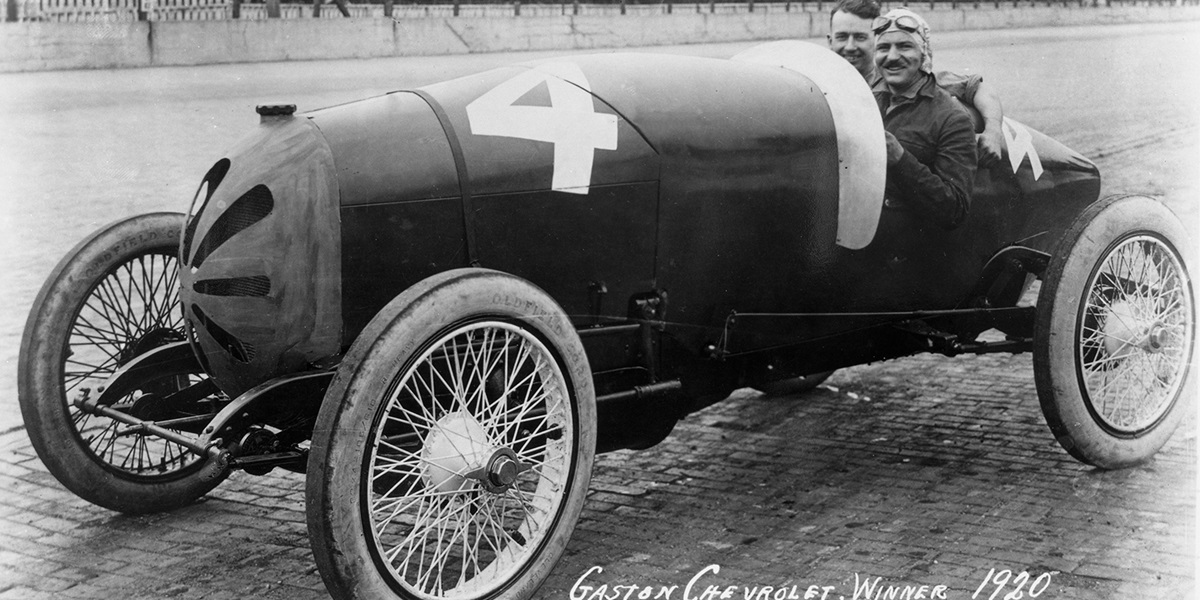
Two Iconic Names Teamed Up To Win Indy 500 in 1920
August 27, 2020 | By Zach Horrall, Indianapolis Motor Speedway
In 1920, one of the most iconic names in American automotive history found its way into Victory Lane at the Indianapolis Motor Speedway: Chevrolet.
Gaston Chevrolet, the younger brother of engineers Arthur and Louis, the namesake of the Chevrolet automobile line, won the Eighth Running of the Indianapolis 500.
In the early days of the Indianapolis 500, then known as the International 500-Mile Sweepstakes, the race was used as a proving ground for automotive innovation.
Each year, those in the automotive industry showed up in Indianapolis and tested what they were working on all year: engines, chassis and even rear-view mirrors. It is believed that the first-known use of a rear-view mirror was in 1911 by Indianapolis 500 winner Ray Harroun.
In 1920, Firestone Tire & Rubber Company used the 500-mile test to see how strong of a tire it could produce for its consumers. Durability on the tough, brick surface was key.
“To begin with, the Indianapolis 500 was not a sport of drivers, it was automobile companies,” Indianapolis Motor Speedway Historian Donald Davidson said. “The idea was that the track was built as a proving ground for private testing, but when they had automobile races, it was an extension of testing. In the very early days, the credit went to the company, not the drivers. The drivers were an afterthought.”
The thought was that if a product or innovation worked in the grueling 500-mile race, then it would work on everyday roads. That was something companies or manufacturers could sell to consumers.
Back then, roads were tough on tires, and the Speedway was no exception. The 2.5-mile course did not have the smooth asphalt surface race fans see today. It was paved entirely with brick and mortar and was not a place for unreliable tires.
One hundred years ago, Firestone produced an extremely durable tire under one of its brands, called Oldfields, that lasted from start to finish for race winner Chevrolet. Nobody in the previous seven editions of the race had won without changing tires.
“It was very notable that the car could go 500 miles and average around 88 mph,” Davidson said. “But certainly, the fact that they never changed tires, that was bragging rights for the tire company.”
Chevrolet’s 1920 victory was not one of domination. Instead, he was consistent and capitalized on the misfortune of others.
Ralph DePalma, the 1915 winner, looked poised to capture his second win in what was then known as the International 500-Mile Sweepstakes. However, the inevitable “DePalma Luck” struck the Italian-American driver when one of the engine’s two magnetos failed, meaning only four of the eight cylinders were firing.
Chevrolet raced passed DePalma and led the final 14 laps, cruising to his first Indy 500 win in just his second start. He finished the grueling 500 miles in five hours, 38 minutes with an average speed of 88.618 mph.
Chevrolet’s race winning car was not a Chevrolet, but it was built by his older brothers. Entered in the race as a “Monroe Special,” the car was a Frontenac, the line of cars Arthur and Louis built specifically to compete at the Speedway.
Chevrolet’s two brothers were engineers that poured their hearts into the innovative nature of the Speedway, just as their younger brother poured his heart into the on-track product.
Just months after his win, on Nov. 25, 1920, Chevrolet died in a racing accident at the steeply banked wooden board track in Beverly Hills, California. Having had such a successful season, Chevrolet accumulated enough points from other races and was posthumously declared the American Automobile Association (AAA) champion.